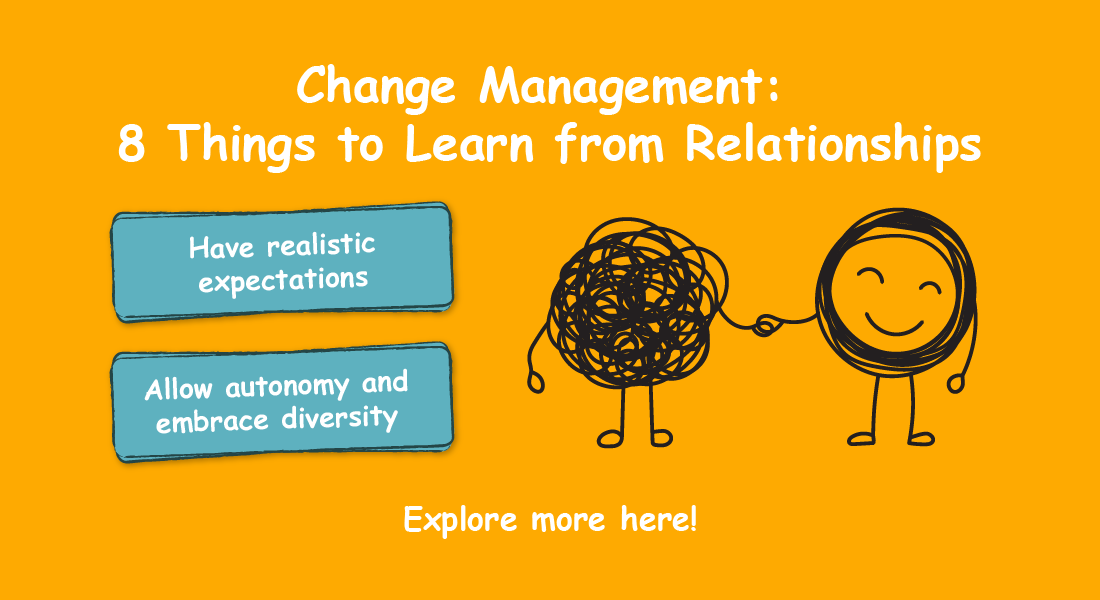8 Things I Learned from Relationships that You can Apply to Organizational Change Management

Have you noticed how some couples break up at the first sign of trouble? Or how others become stronger, even when faced with the same obstacles? It doesn’t matter what the obstacle is. Financial problems, extramarital affairs, and living apart because of work, all affect a marriage. Some marriages dissolve under the pressure, while others grow stronger. Why the difference? And what can this teach us about our attitude to organizational change management?
8 Relationship Lessons Applied to Change Management
- Be together for the right reasons
- Have realistic expectations
- Respect each other and communicate
- Be selfish to reach a happy compromise
- Allow autonomy and embrace diversity
- Don’t confront, carefront
- Create milestones
- Establish relationship rules
People Stay Together for the Same Reasons
I decided to do some digging, to learn what made people stay in a relationship even when the going gets tough. I discovered an article titled ‘Every successful relationship is successful for the same exact reasons’. Fascinating stuff. The author, Mark Manson, was getting married soon. He wanted his marriage to work. So, he had a bright idea to help him be the best husband he could be.
Manson asked for advice from couples who had been together for more than 10 years. He asked what made their relationships work. Almost 1,500 people answered. He discovered that their responses were ‘incredibly repetitive’. It appears that people stay together for the same reasons.
Lasting Relationships are Resilient
Strong couples build resilience. They fight for the relationship. They don’t give up. What couples said kept them together could serve as a blueprint for resilience at work.
I’ve condensed the advice into these eight behaviors to build resilience at work, and through change.
Organizational Change Management: 8 Things to Learn from Relationships
1. Be Together For the Right Reasons
If you stay with a person for the wrong reasons, the relationship will most likely fail. Family might pressure you to marry. You may feel like a loser if you are single. You may ‘feel sorry’ for your partner. You may get married because you got pregnant. Sooner or later you lose interest. On the other hand, if you believe in the relationship, you’ll fight for it. Tooth and nail.
You must believe in your change project. It is this buy-in that drives resilience. If you believe in the change, you’ll fight for it.
2. Have Realistic Expectations
Love can cloud your judgment. It blinds you. Over time, the initial love rush fades, and real love comes in. You set realistic expectations together. You make a commitment to the relationship.
In the context of organizational change, take time to step back. Examine the reasons for change, and ensure you maintain realistic expectations for outcomes.
Explore how you can rollout training at the speed of business needs with rapid eLearning.
3. Respect Each Other and Communicate
It’s important to communicate. Openly and honestly. Frequently. Discuss everything. Especially the painful stuff. To do this, you must respect each other.
Change leaders must also respect their people. You must communicate, be open to different points of view, listen, and act. When you show this level of respect to another, it will be returned.
4. Be Selfish to Reach a Happy Compromise
Of course, you want to make your partner happy. You’ll need to make sacrifices. But you mustn’t sacrifice your soul. Sacrifice your happiness for the sake of your partner’s and the end is inevitable.
During change, it is necessary to be a little selfish. You have your personal goals. If you sacrifice these, your desire to make the change work will evaporate.
5. Allow Autonomy and Embrace Diversity
It’s important to have your own interests and your own space. You’ll have more to talk about, and you won’t stifle each other. Allowing autonomy shows trust. It encourages diversity. Strong couples embrace this diversity. Love for their partners grows stronger because they embrace evolutionary change.
A good change leader trusts their people. Together, they create solutions to problems they encountered. Let your people take responsibility through change, give others the space to work autonomously, encourage them to bring their views to the change discussion. Embrace the diversity and it will deliver.
6. Don’t Confront, Carefront
When relationships break down, the fighting begins. It all gets personal. You throw criticisms like punches. When you use your partner as a verbal punchbag, it’s hard to rationalize problems. Instead, you shift the blame. You treat your partner with contempt, or you stop talking to each other.
No change project ever ran smoothly. There are hurdles you must negotiate. When things don’t happen as expected, resist the temptation to be confrontational. Instead, take a carefronting approach:
- Don’t criticize the person – listen and understand diverse points of view.
- Accept responsibility and be accountable for your actions.
- Treat others with respect and as equals – avoid the blame game and learn to forgive.
- Be open and honest, and encourage compromise.
Organizations that have a culture of carefronting are good at change management.
7. Create Milestones
In a marriage, the little things add up to big things. I have a friend who kisses his wife goodnight and says, “I love you” before he falls asleep. When he wakes, he kisses his wife and tells her he loves her. He calls it his daily milestones. Over the 32 years of his marriage, those little milestones added up to a big bucket of love.
Break a project into smaller, achievable milestones. Each time you achieve a milestone, you move a step closer to the project goal. It all adds up.
8. Establish Relationship Rules
In a relationship, you share responsibilities, but rarely equally. Usually, you share them according to ability, time, and interest. You share them pragmatically. Setting out relationship rules removes room for conflict. How much can you spend without asking your partner? What bills are you both responsible for? How do you decide where to go on vacation?
Rules are necessary for the workplace, too. They help you know what your responsibilities are. They determine the chain of command. They shape acceptable behaviors.
Ride the Waves of Change with Resilience
Relationships ebb and flow. You must take the rough with the smooth. It is the same during periods of organizational change. There will be times when you ask if it is worth the effort. This is when you must refocus on your goals. Revisit the reasons for the change to re-energize your efforts. Resilient leaders, employees, and teams ride the waves of change.
Change is often the only way to move forward, be it in relationships, organizations, or technology. And you need to adapt to these changes to keep pace in today’s world. One such change that will tremendously affect you in the coming months is the phase out of Flash. With the end of 2020 just a few months away, it is high time to get ready for the Flash to HTML5 conversion of legacy eLearning courses. For details, download our eBook.




![Relationships and Organizational Change Management [Infographic]](https://blog.commlabindia.com/hubfs/Imported_Blog_Media/change-management-organizations-relationship-lessons.jpg)
![How to Design an Engaging Change Management Training Program? [Infographic]](https://blog.commlabindia.com/hubfs/blogs/change-management-training-design-tips-info.jpg)
